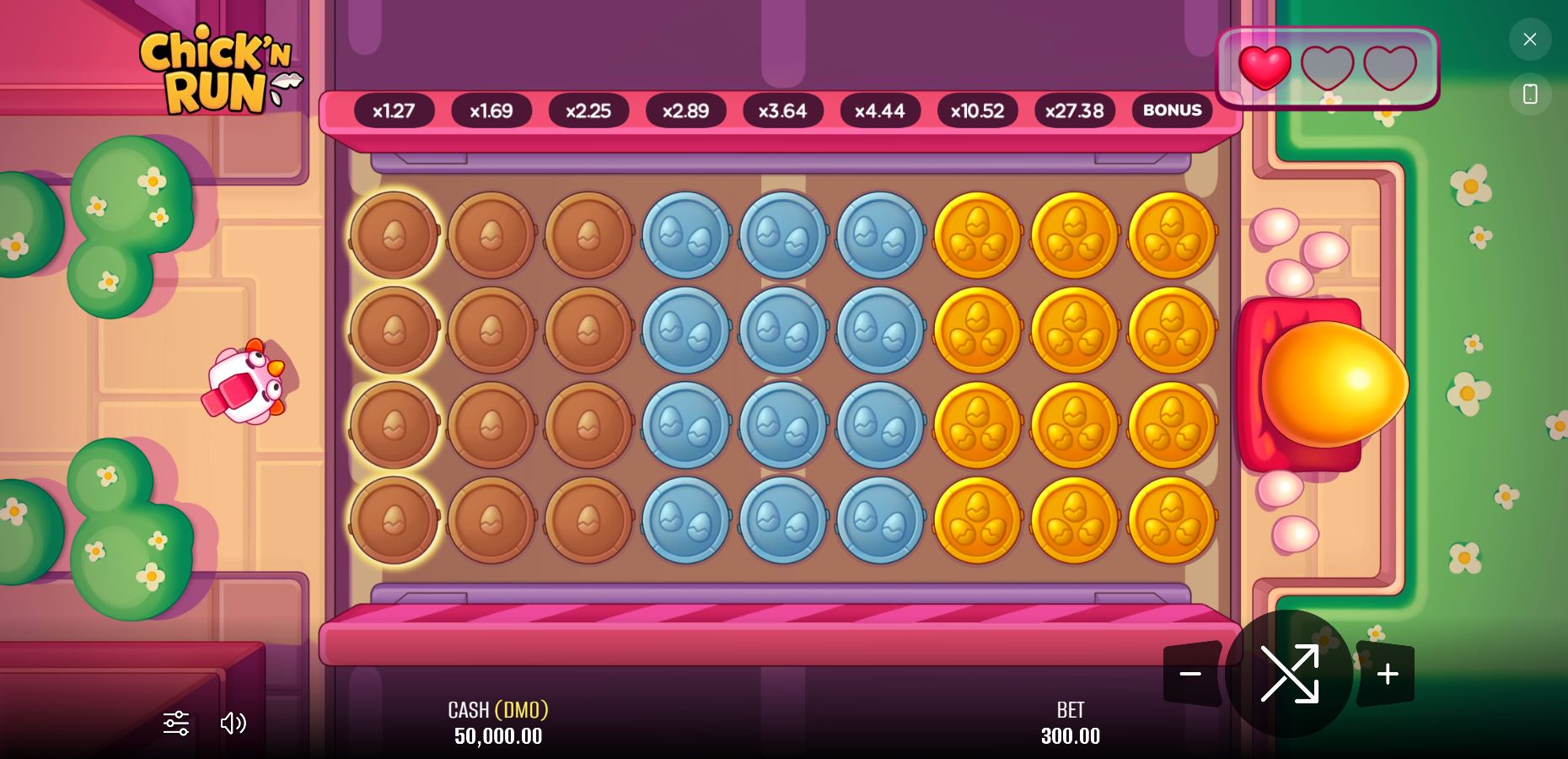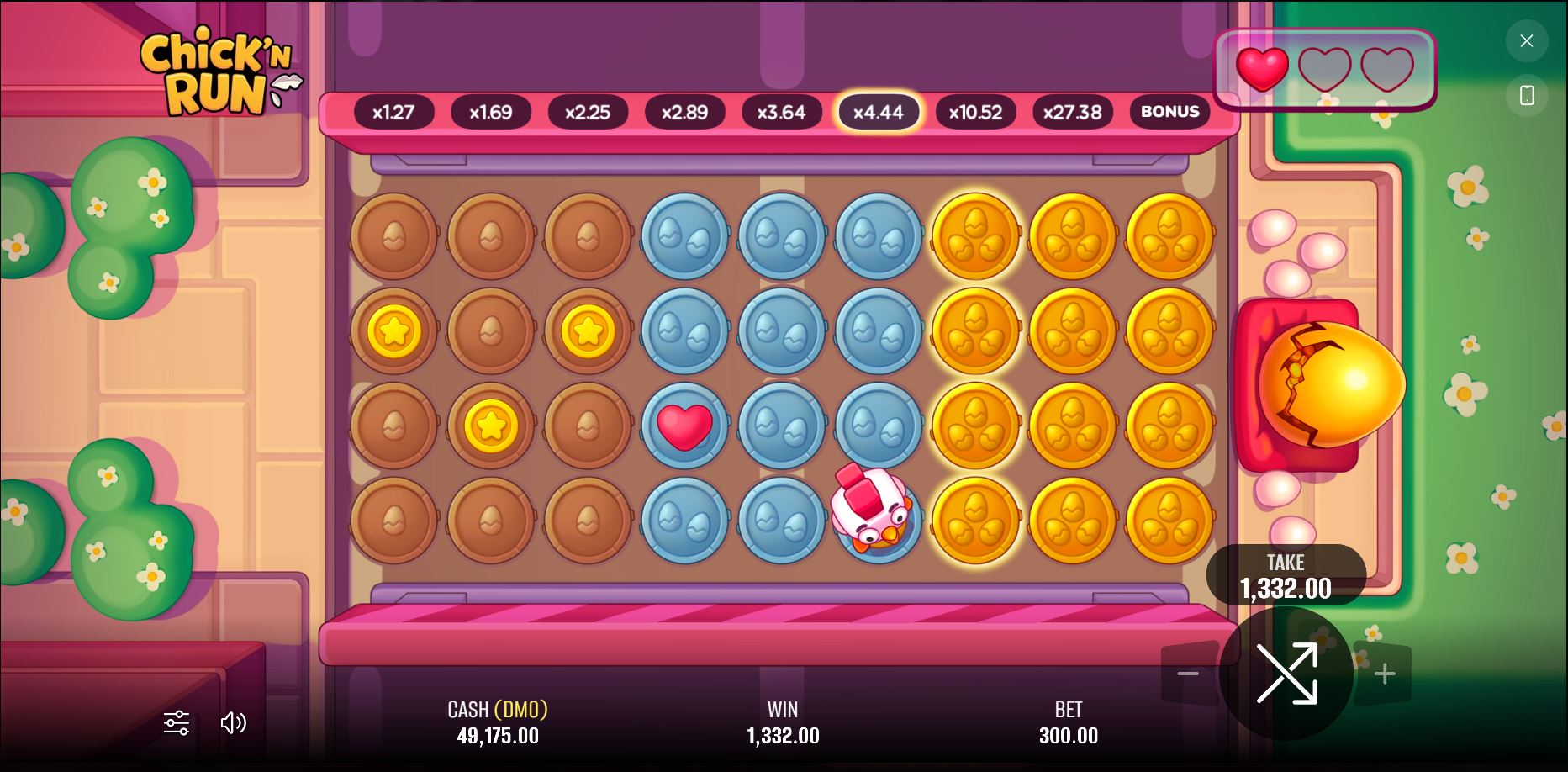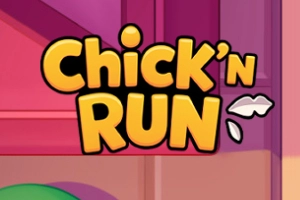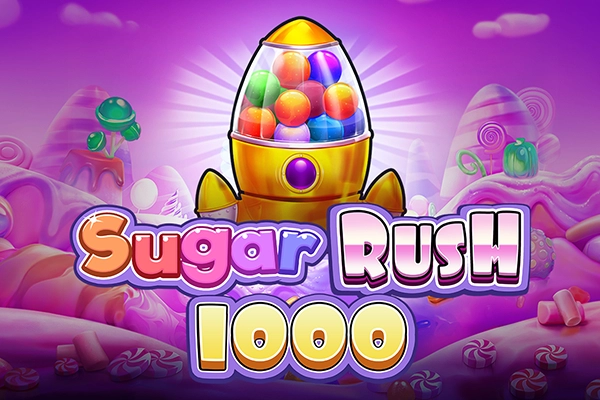Guide a chicken across a treacherous grid in Pixmove’s Chick N’ Run! This medium volatility instant game has a 95% RTP. Dodge sewers and build multipliers to win 500x.

Chick N' Run Game Features
| Feature Name | Description | Trigger / How it Works |
|---|---|---|
| Coin Tile | A safe step that increases the overall win multiplier. | Click on a hidden tile to reveal a Coin. |
| Heart Tile | Grants an extra life, allowing you to survive one Sewer tile. | Randomly revealed by clicking on a hidden tile. |
| Spring Tile | Pushes the chicken back one step on the grid. | Randomly revealed by clicking on a hidden tile. |
| Sewer Tile | An instant trap that ends the current round. | Randomly revealed by clicking on a hidden tile. A Heart will negate its effect once. |
| Golden Egg Bonus | A pick-and-click bonus round with hidden multipliers. | Reach the final tile on the grid (the Golden Egg). |
| Cash Out | Allows the player to collect their current winnings at any time. | Click the “Take” button before revealing the next tile. |
What is the Core Gameplay of Chick N' Run?
The core gameplay of Chick N' Run revolves around direct player choice within a grid-based path. Instead of spinning reels, you click on hidden tiles one by one to guide a chicken forward, with each step presenting a risk or a reward that builds upon the last.
This game belongs to a category of Arcade Games where your decisions directly shape the outcome of the round. The objective is to advance as far as possible, increasing a win multiplier with each safe step. The challenge lies in avoiding “Sewer” tiles that end the game. You start with one life, but can collect “Heart” tiles for extra chances. At any moment before clicking the next tile, you can choose to cash out your accumulated winnings, making the entire experience a constant test of nerve.
How Do Multipliers Work in the Chick N' Run Demo?
Multipliers in the Chick N' Run demo increase sequentially with every safe “Coin” tile you uncover. The game features a visible multiplier ladder, starting at 1.27x and climbing with each successful step, potentially reaching over 27x before the final bonus.
The multiplier applies to your initial bet. For example, if you place a 10-credit bet and advance five safe steps to a 3.64x multiplier, your potential win is 36.40 credits. You can lock in this win by cashing out. The further you go, the steeper the multiplier increases, creating a high-risk, high-reward scenario as you approach the Golden Egg. This system is transparent, allowing you to calculate your exact risk versus reward before every single click.

The Four Tile Types: Your Tools and Traps
The grid is populated with four distinct tile types, each with a specific function that defines your run.
- Coin Tile: This is the most common and desirable outcome. It marks a safe step, moves your chicken forward, and increases your win multiplier according to the ladder.
- Heart Tile: The game-changer. Revealing a Heart grants you an extra life. This means you can survive hitting one Sewer tile without your run ending. You can stack multiple hearts.
- Spring Tile: A minor setback. This tile pushes your chicken back one position on the grid. It doesn't end your run, but it erases your last step of progress, forcing you to re-tread ground you already cleared.
- Sewer Tile: The run-ender. If you uncover a Sewer and have no hearts, the game is over, and you lose your bet and any accumulated multiplier.
Understanding the Math: Chick N' Run Volatility and RTP
Chick N' Run operates on a medium volatility model with a stated RTP of 95%. This mathematical framework means the game provides a balanced experience, where wins are neither excessively rare nor consistently small, but the lower-than-average RTP suggests the house edge is slightly higher than in many modern slots.
The medium volatility is directly influenced by player choice. A conservative strategy of cashing out after only a few steps results in low-volatility gameplay with frequent small wins. Conversely, consistently pushing for the Golden Egg introduces high volatility, leading to many lost rounds punctuated by occasional significant payouts. The RTP of 95% is a theoretical long-term average. In a session of this interactive Animal game, your personal return can deviate wildly based on your risk tolerance and a good dose of luck. The math here feels less like the rigid probability of a slot like Mustang Gold and more like a fluid system you can nudge.
What if Chick N' Run Had a “Bet on a Column” Feature?
Let's break the fourth wall for a second. Imagine this. What if, before a run, you could place a side bet on a specific vertical column being completely free of sewers? Say, you bet an extra 20% of your stake that the fourth column is all clear. If you're right, you get a 5x payout on that side bet, completely independent of your main run. It would transform the game, wouldn't it? It would shift a part of the gameplay from a linear, step-by-step progression to a more calculated, almost statistical analysis of the grid. You'd be thinking about probability zones, not just your next step. A small change, but it would add a layer of strategic depth that would appeal to a different kind of player. Just a thought.
The Golden Egg: Unlocking the Bonus Game
The Golden Egg is the ultimate goal of any run, acting as the trigger for the game's only bonus feature. To activate it, you must successfully navigate the entire grid of tiles from left to right and land on the final space where the egg rests.
Reaching the Golden Egg is the climax of the base game. It represents surviving all the potential traps and requires either significant luck or the strategic use of collected Heart lives. Once triggered, the game transitions from the grid traversal mechanic to a dedicated bonus screen, offering a different style of play focused on rapidly accumulating additional multipliers to apply to your already-substantial win from the run itself.
Vlad Hvalov's Expert Tip: “In the demo, my first goal isn't to reach the egg. It's to find my ‘no-heart' cash-out point. For me, it's usually 2.25x. I bank it every time if I don't have a heart. This builds discipline and helps you understand the game's rhythm without any risk.”
How the 9-Pick Bonus Round Magnifies Wins
The bonus round is a classic ‘pick me' style game that presents you with 9 golden coins. Behind each coin is either a multiplier value (e.g., x2, x8, x64) or a “Cash Out” symbol. You click the coins one by one, and each revealed multiplier is added to a bonus total.
The round continues until you reveal the “Cash Out” coin. At that point, all collected bonus multipliers are summed up and added to the multiplier you already earned by reaching the egg. For instance, if you entered with a 27x multiplier and collected x8, x16, and x2 before hitting “Cash Out,” your final multiplier would be (27 + 8 + 16 + 2) = 53x your bet. This structure allows for explosive win potential in a very short time. The tension comes from not knowing which pick will be your last. This feels more engaging than the free spins rounds in many Money themed slots where you just watch things happen.
Strategic Approaches to the Chick N' Run Free Play Demo
Playing the Chick N' Run demo is the perfect environment to develop and test strategies without financial risk. The key is to define your own rules for engagement, primarily centered around when to use the cash-out feature based on your current number of extra lives.
A solid starting point is to establish different goals. For example, with zero hearts, aim for a conservative cash-out at a low multiplier like 1.69x or 2.25x. If you collect one heart, you can justify pushing further, perhaps to the 4.44x or 10.52x mark. With two or more hearts, a full run for the Golden Egg becomes a more statistically viable option. This tiered approach helps manage the game's inherent risk and prevents reckless decisions. This level of strategy is rarely seen in simple Fruit-themed games like Inferno Strike Dream Drop.
Vlad Hvalov's Expert Tip: “Don't underestimate the Spring tile. It feels like a punishment, but sometimes it's a blessing. I've been pushed back from a tile that I know had a sewer next to it. It gives you a free ‘re-roll' on your next move. Use it as a moment to pause and reconsider your path.”
When Should You Use the Cash Out Feature?
The decision to cash out is the most critical strategic choice you make in Chick N' Run. There is no single correct answer, but the best time to cash out is when the risk of losing your accumulated multiplier outweighs the potential reward of the next step.
To make an informed decision, consider two factors: the multiplier ladder and your number of hearts. The multiplier increases are small at the beginning of the run but grow exponentially larger toward the end. Therefore, the risk is lowest for the smallest rewards. A sensible strategy is to cash out early and often if you have no hearts. If you have one or more hearts, you have a safety net that justifies pushing for the larger multipliers in the middle and end of the grid. The key is to be disciplined and not let greed dictate your clicks, a lesson that can be learned by playing similar risk-based games like the crash game found in Avia Masters Demo.
The Contrarian View: Why Chasing the Egg is Often a Flawed Strategy
Here's the hard truth: for most players, constantly aiming for the Golden Egg is a losing proposition. The allure of the big bonus payout is strong, but the probability of navigating the entire grid is low. The game's mathematics, especially with a 95% RTP, favors the house on those long, high-risk runs.
A far more consistent, if less thrilling, strategy is “grinding.” This involves setting a low, achievable multiplier target—say, 2.5x—and cashing out every single time you reach it. While you'll never hit the 500x max win this way, you accumulate a steady stream of small, consistent profits. The emotional rush is gone, replaced by a disciplined, almost robotic execution. It's not as fun, and it won't give you a story to tell, but from a purely statistical standpoint over thousands of rounds, it is arguably the more logical way to play. The game baits you with a jackpot you're unlikely to get, while the real value lies in the small wins it's willing to give up easily.
Secrets of the Coop: 3 Facts About Chick N' Run
- Sound Design Psychology: The “coin” reveal sound has a slightly higher pitch and quicker decay than the “heart” sound. This is a subtle audio cue designed to make the more common, less valuable reward feel more instantly gratifying and “snappy.”
- The “Spring” Failsafe: In early development builds, the Spring tile could reportedly push you back into an already-revealed Sewer tile, ending your run unfairly. This was changed to ensure a Spring always lands you on a safe, previously-cleared spot.
- Color-Coded Risk: The background color of the tile grid isn't just for decoration. The tiles in the first section are bronze, the middle is silver, and the final stretch is gold. This subtly communicates the increasing risk and multiplier value as you progress, a visual guide to the rising tension.
My Personal Log: A 400-Click Session Report
I started my session with a 50,000 demo credit balance and a bet of 100 per run. My plan was simple: play it safe. My first 50 clicks were a mix of quick cash-outs around 2x and a few frustrating first-column sewer busts. The balance dipped to around 48,000. It felt grindy. The rhythm was tap-tap-cashout, tap-sewer. Boring, but I wasn't losing much.
Then I decided to change things up. I upped the bet to 300 and decided to push any run where I found a heart in the first two columns. This is where the game opened up. I had a run where I found two hearts early. I felt invincible. I pushed past the 10.52x mark, heart pounding a bit, and made it to the golden egg with a 27.38x multiplier banked. The bonus game started. My first pick was a juicy x32 multiplier. My second was a “Cash Out.” Drat. Still, the total payout was (27.38 + 32) * 300 = 17,814 credits. The balance shot up to over 65,000.
Feeling flush, I got greedy. I started pushing every run, regardless of hearts. The balance started to bleed. A 10x run was lost. A 15x run was lost. The sewers felt like they were everywhere. After about 350-400 total clicks, my balance settled at 58,200. A decent profit, but a clear lesson learned: the game rewards disciplined aggression, not blind hope. The session felt like a condensed version of a long night at a poker table—long stretches of cautious plays, a sudden spike of a huge win, followed by the temptation to overplay your hand.
Chick N' Run Compared to Other Instant Win Games
When placed alongside its peers, Chick N' Run carves out a unique niche. It lacks the sheer, simple velocity of pure Crash Games, but offers more direct interaction. It's more strategic than a standard game of Plinko Games, where you just drop a ball and hope. Its closest relatives are “Mines” style games, but the inclusion of Hearts and Springs gives it more mechanical depth than just “click and don't explode.”
Compared to a tile game like Mahjong Phoenix, Chick N' Run is infinitely simpler and faster-paced. It's not about pattern recognition but about pure risk assessment. It shares a thematic playfulness with some animal-themed adventure slots like 3 Lucky Hippos 2, but the gameplay couldn't be more different. Ultimately, it’s a game for players who want the risk/reward loop of a crash game but with the feeling of being in the driver's seat for every single step. For more variety, you can always check out the full collection of demo online slots available.
Our Verdict
Chick N' Run is a refreshing change of pace. It's a game of nerve and numbers, packaged in a charming, cartoonish theme. It successfully strips away the passive nature of watching reels spin and puts every decision squarely in your hands. The mechanics are easy to grasp but offer a surprising amount of strategic depth, centered entirely on the “cash out or continue” dilemma. The Heart feature is a brilliant touch, providing just enough of a safety net to encourage bolder plays.
The 95% RTP is the game's most notable weakness, sitting a full point below the industry standard. This makes long-term, high-risk strategies statistically challenging. However, for what it is—a quick, engaging, decision-based instant win game—it excels. It's not trying to be a complex video slot; it's an arcade-style test of risk management.
I'd strongly recommend playing the Chick N' Run demo. It’s the perfect way to understand the flow and find a strategy that fits your comfort level. It’s a game that respects your choices, for better or worse. If you enjoy titles that reward discipline but still offer that shot of adrenaline, this little chicken's frantic dash is definitely worth your time.
FAQ
No, it is an interactive instant win game. Instead of reels, you reveal tiles on a grid, and your choices directly determine the outcome of each round.
The maximum potential win in Chick N' Run is capped at 500 times your total bet, achievable through a combination of grid multipliers and the Golden Egg bonus.
The bonus game is triggered by successfully guiding the chicken across the entire grid to reach the Golden Egg waiting at the very last tile.
The official Return to Player (RTP) for Chick N' Run is 95%. This figure is a theoretical average calculated over a vast number of game rounds.
A solid strategy is to be conservative. Cash out on small multipliers when you have no extra lives (hearts), and only push for the end of the grid when you have collected one or more hearts as a safety net.
Chick N' Run is classified as a medium volatility game. Your personal experience of volatility, however, will change depending on how aggressively you play.
You can play a full and completely free demo version of Chick N' Run right here on Respinix.com to test strategies and enjoy the gameplay without any risk.
 Chick'n Run
Chick'n Run












